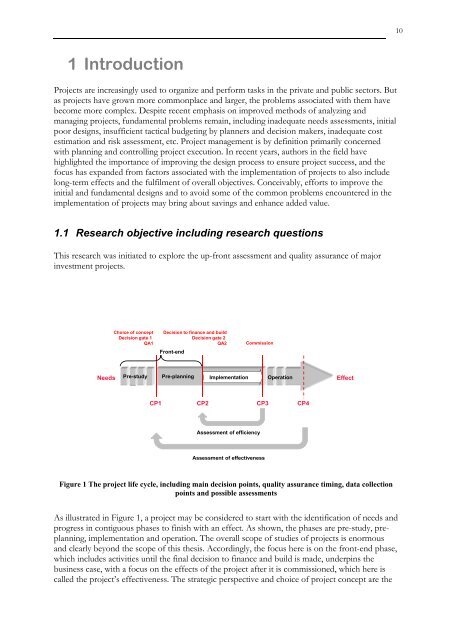Link to thesis. - Concept - NTNU
Link to thesis. - Concept - NTNU
Link to thesis. - Concept - NTNU
- No tags were found...
You also want an ePaper? Increase the reach of your titles
YUMPU automatically turns print PDFs into web optimized ePapers that Google loves.
101 IntroductionProjects are increasingly used <strong>to</strong> organize and perform tasks in the private and public sec<strong>to</strong>rs. Butas projects have grown more commonplace and larger, the problems associated with them havebecome more complex. Despite recent emphasis on improved methods of analyzing andmanaging projects, fundamental problems remain, including inadequate needs assessments, initialpoor designs, insufficient tactical budgeting by planners and decision makers, inadequate costestimation and risk assessment, etc. Project management is by definition primarily concernedwith planning and controlling project execution. In recent years, authors in the field havehighlighted the importance of improving the design process <strong>to</strong> ensure project success, and thefocus has expanded from fac<strong>to</strong>rs associated with the implementation of projects <strong>to</strong> also includelong-term effects and the fulfilment of overall objectives. Conceivably, efforts <strong>to</strong> improve theinitial and fundamental designs and <strong>to</strong> avoid some of the common problems encountered in theimplementation of projects may bring about savings and enhance added value.1.1 Research objective including research questionsThis research was initiated <strong>to</strong> explore the up-front assessment and quality assurance of majorinvestment projects.Choice of conceptDecision gate 1QA1Decision <strong>to</strong> finance and buildDecision gate 2QA2Front-endCommissionNeedsPre-study Pre-planning Implementation OperationEffectCP1 CP2 CP3 CP4Assessment of efficiencyAssessment of effectivenessFigure 1 The project life cycle, including main decision points, quality assurance timing, data collectionpoints and possible assessmentsAs illustrated in Figure 1, a project may be considered <strong>to</strong> start with the identification of needs andprogress in contiguous phases <strong>to</strong> finish with an effect. As shown, the phases are pre-study, preplanning,implementation and operation. The overall scope of studies of projects is enormousand clearly beyond the scope of this <strong>thesis</strong>. Accordingly, the focus here is on the front-end phase,which includes activities until the final decision <strong>to</strong> finance and build is made, underpins thebusiness case, with a focus on the effects of the project after it is commissioned, which here iscalled the project’s effectiveness. The strategic perspective and choice of project concept are the
















